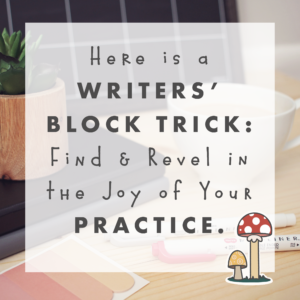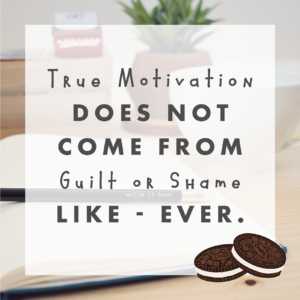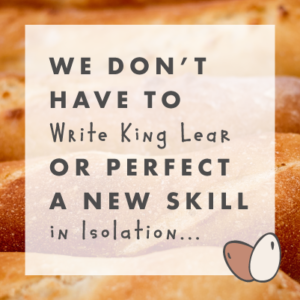Free Prewriting Worksheet: The 5 Keys to Unlock Prewriting
Why Keys?
When I taught Writing at a local private school, here in Moncton, I had to use some clever tricks to keep my students from jumping straight to Drafting. Remember the elephant story? They were trying to eat the whole stinkin’ elephant in one bite, and you and I know that doesn’t work out well for anyone.
After jumping up and down and saying NO NO NO one too many times, I finally decided that it wasn’t working. Using the Writing Process is really an important part of pain-free and effective writing, so I couldn’t give up. I needed to change my tactics to make it stick.
I did what every teacher does when they need to get an important thing across to their students: I went to a local craft supplies store.
I got a package of binder rings, stiff construction paper and lots of markers, and made a Prewriting Key Chain for each of my students.
I cut out 5 key shapes from the construction paper for each student and wrote the following 5 steps on them. I then told my students that they had to get all of the 5 keys in order to open the door to Drafting. Until they had all of their keys, they were LOCKED OUT.
It worked really well! I drew a different cartoon door on our white board every day with 5 elaborate looking locks. From then on, my kids always remembered to get their keys for each step before they tried to come up and open the door to the next step and start Drafting their project. Success!
Now, you are all grown-ups with your own keychains filled with keys for all kinds of different doors and responsibilities.
You don’t need another keychain to carry around, and I can’t actually hand out little cut-out keys for you to put on your project keychain, so I will give you the steps.
AND I will give you a great checklist that you can print out and place on the wall in your writing space. You can make yourself a keychain, if you like, but I think the beautiful checklist will work very nicely…and you won’t leave the house with it in your hand, thinking it’ll start your car.
Here are the 5 Keys – Make sure you gather them all for each and every writing project you do:
1. Audience
If you are writing an article for a technical journal, your audience will expect different kinds of content, language and information than if you are writing a blog post for clients you could help in the future, who don’t have that technical jargon or experience.
If you write to the wrong audience, the people you want to reach will *click* leave you in the dust.
So you have to decide NOW who you are talking to, and then do some research about what they want to hear from you.
You have to know your audience in order to really talk to them, and when I say “know” them, I mean really know them. You have to imagine one specific person who exemplifies your ideal reader, and ask yourself (or them) about all kinds of things: their favourite hobbies, hopes, dreams, fears, even their favourite TV shows.
2. Purpose
I hear this all the time: “I want to make sure that I say…” or “I have to tell them…”
No you don’t. Stop it.
[click_to_tweet tweet=”Let me make this clear right away because it is *super* important: YOUR PURPOSE AS A WRITER IS NOT TO SAY THINGS!” quote=”Let me make this clear right away because it is *super* important: YOUR PURPOSE AS A WRITER IS NOT TO SAY THINGS!”]
Your purpose is to affect someone. You want your reader to think, feel, or do something because of what you say. Take yourself outside of what you know or what you want to say, and think about how your reader should feel.
Decide one specific thing that you want to happen as a result of your reader taking the time to read your piece, and do everything with the intent to make that happen.
[click_to_tweet tweet=”Your Purpose as a writer is NOT to say something; it’s to affect someone, on purpose” quote=”Your Purpose as a writer is NOT to say something; it’s to affect someone, on purpose”]
People come to the internet for 1 of 3 things: Information, Entertainment or Inspiration.
Use one of those things to fulfill your purpose. Do it on purpose.
3. A Great Idea
We need topics to write about, and we need them to be good, right? Obviously. But how do we make sure our topics are good and will affect our readers in the way we want them to? PLAN! (of course)
Start out by reading this post on Quarterly planning, and follow the steps to fill in the template I provided there. This will make certain that you are writing about timely and important messages, and it will give you a starting point for your Topic brainstorm.
The key here is to let every single idea pour out onto the page. Never say no to yourself here, and expand on even the silliest of ideas, because the best ideas often come from the worst.
4. Organized, Categorized Outline
This is the map that you will follow during drafting, to make sure that you cover all of the important points and in the right order.
It will keep you from drifting off and talking about irrelevant things, and it will make sure that you cover your points in a rational and organized way.
It will also take that painful fear away from Drafting – the white, blank page! You will know what to do and when to do it, so all that you have to do with that page is expand on the points you have written down, in lovely sentences.
BUT HOW? Just start simply:
– Make 3 good points about your topic, then make 3 good sub-points about each point.
– Organize that crap so it makes sense! Decide on a logical order to put your points in so that your audience can follow along and grasp the important bits. Pay attention to the organization of others’ writing too – you will begin to notice the most effective ways to organize your thoughts.
5. Words, Baby!
You are ready for the last Prewriting step! It’s time to do some exercises to make sure your vocabulary around the topic you are writing about is warmed up and ready so you don’t waste time staring at the screen and waiting for the right word to show up.
This step gets skipped sometimes, but you really should do it. Seriously!
It’s simple and can take 30 seconds, but it will rev up your linguistic brain and make the words flow more comfortably and genuinely when you do sit down to Draft your project – without the awkward blips that can happen when you use a thesaurus on the spot.
– Write the important words in the Topic, Points and Sub-points on a page. You just started a Word Bank!
– Read about your topic. Find even one magazine article about it and highlight a handful of words you like. Add ’em to the Bank!
– Talk about the topic out loud. The words that come to mind in this natural way will feel natural to the reader as well.
– Come up with a few metaphors. Don’t use more than one in the post, but thinking of different ways to describe an idea will open your mind to new language to use.
– Hit a thesaurus…don’t actually hit it. Open it. Then, use it: go on the thesaurus bunny trail and find the most delicious and comfortable words about your topic. Write those in your Bank too, but make sure that you know how to use each word in a sentence; it is pretty awful when a thesaurus-word gets used incorrectly.
Having these words in your mind will make writing the actual Draft feel so much more free and the words will flood out happily to describe your points, instead of trickling grumpily.
There you go! That’s it for today. Click to download the Checklist, print it and then put it above your workspace. Make sure you follow it with each writing project you work on, and gather your Prewriting Keys before you try to unlock the door to Drafting.
Comment below with a great brainstorming tactic you use, and don’t forget to click Share, Like or Tweet to share this advice with your friends who could use it.
xo
Kris
You mad? Excited? Have a perspective to share? Please do!
15 Comments
Leave a Comment
Want to read more? Check out these recent articles.
The Joy of Writing: Find it in these three places to use on a rainy day.
Scene: you’re at your desk, hands dancing over the keys. Click clack clickity clackity click clack – swish. Now, layer that satisfying typewriter sound with a movie soundtrack in a major key – both invigorating and also somehow relaxing. The victory song – the joy of writing. There’s steam dancing from a coffee cup that…
Writing Resistance: The War of Art, or an Emotional Tiger Hunt?
Four rules to help you avoid Writing Resistance (and tiger bites) even when you’re stressed.
Intrinsic Writing Motivation isn’t built on guilt or shame.
Writing motivation comes in two forms. One works better than the other, but they’re both important – and neither should hurt.
Why you shouldn’t write King Lear right now, and what to do instead.
Oh there’s that meme again. You know the one about Shakespeare writing King Lear during the plague, or whatever. Or the other one saying that you never lacked “time” but rather you lack “discipline” unless you create or learn or complete some amazing life-goal right now. Maybe it’s a stream of pictures of *perfectly baked*…
“Just Start,” is the worst advice I’ve ever heard…or given.
I think those two words have hurt me more than my three worst ex-boyfriends…combined! Not because it’s bad advice to tell a person to just start the things they want to create. But because productivity for productivity’s sake – sucks. “Just Start!” is great advice if the problem you’re having is that you have a…
If I had a Writers’ Sub Box for #30DaysWithaK today, what would I put in it?
One of the key elements of a rich Writing Practice is the act of purposefully adding a sense joy & luxury to it. That doesn’t mean that you have to scream-laugh while you draft a blog post – or purchase a solid gold desktop to hide behind. But it does mean that we can find…






[…] the actual Writing Process without stressing yourself out, and you’ve downloaded a lovely checklist to remind you of what you absolutely have to do before you even start […]
[…] to me. It allows your rational brain to plan, research and outline your writing like a map (Prewriting), so that your creative mind can come back later and explore without getting […]
[…] now that will help you to build a beautiful and effective Signature Story for your brand; this is Prewriting in action, kittens, and it is going to be […]
Hi Kris,
I love all your great tips they make so much sense to me. I have consistently committed to the Free Writing process for 3 weeks and have babbled on to myself on every topic from friendship to radishes(long story regarding radishes). What I have learned with this unstructured approach is to write with my feelings rather than ‘how i think something should be written’. Not sure if that makes sense but it seems to work for me. Now ready to move to the next phase of taking a more structured approach to writing…. just baby steps !!!
Thank you for all your wonderful posts they keep me inspired and moving towards my somewhat ‘mirage goal’ of writing a book.
Annette – I love this! I’m so glad you have stuck with it; consistency is really the key to getting the most out of your Writing Practice AND that idea about writing what you think you are supposed to write? That’s a creativity killer for sure. I’m super pumped that you’ve been able to find your writing confidence and you’re trusting your own Voice 🙂 Awesome!
xo
K
[…] Prewriting – this is where you figure out and plan ahead all of the important bits and pieces before […]
[…] but if you are writing with a purpose you can’t just sit down and GO without some effective Prewriting […]
Thank you for sharing your blog and helpful information. I am not good at writing, so I will be reviewing these 5 steps later, again and again to help me. I like how you make learning fun for your students.
I am coming from the New Blogger group on Facebook enjoying the Blog tour. There really is too much to share from April. She is amazing. I enjoyed reading your blog because it is so conversational. Great job! If you want, you can check my blog out at http://www.timecapsule.com/blog. We love to receive comments and shares about our decorative Baby and Wedding Time Capsules as well.
I learned a lot from April about ways to help our business through our blog, so my husband was very understanding that I was watching Creative Live for several hours, to help us advance our lives and business.
Best of Luck to you,
Marcie Norton
@NewTimeCapsule
http://www.timecapsule.com
Thanks Marcie! I’m glad you will be able to use this resource 🙂 April really was fantastic! I’m so glad to have become a part of this new group of writers, and I can’t wait to see how we all grow.
xo
Kris
Wow!! This is extremely helpful, Kris!! I’ve printed it out and will definitely use it for my upcoming blog posts! I struggle with writing and I feel a large part of it is due to the fact that I don’t do the pre-writing step. I also think I should follow a writing schedule, that will help build discipline and force me to be more consistent.
Also, I love your teaching story!! I used to be an elementary teacher and I miss the creative lessons we used to do!! Your story brought back so many memories. Actually, my first group of first graders will not be graduating high school next week! Yikes! Time is flying.
Thanks again.
I’m glad you feel like this resource will help you, Jennifer! I think planning is a huge part of any communication; think about your outline as though it’s the lesson plan for a great lesson you will teach during the Drafting step. Some of my lesson plans were 5 bullet-points written on a napkin, but there was always an intentional plan written somewhere before I walked into the class. Otherwise, MAN it was not a good experience for anyone.
My first classes were in High School, so they’ve long since left school, but seeing them now and then – all adult and responsible – is still pretty shocking. I can’t imagine if they started out with me as tiny ones!
xo
K
What a creative way to explain this concept to children! I wish I had a teacher like you back in the day 🙂
Thank you for this super useful information, I’ll use it for sure.
Thanks Nela! I swear, those students taught me more about communication than I ever taught them. This lesson: if you’re not getting your message across, repackage it 😉
xo
K
Very good ideas on writing before the draft, I really like how you were very creative with the children too! – I usually just jump in with the draft, having thought through what I want to say. I do a lot of preliminary reading though – the Internet is wonderful for information, but I choose wisely which bits to use for any writing I need to support.
I’m happy to hear that you do some thinking ahead of your draft, Lynne. Try making a quick, concrete outline next time you write something; it can take 30 seconds, and it can make an *enormous* difference to your final product. A great return on time investment 🙂
xo
K